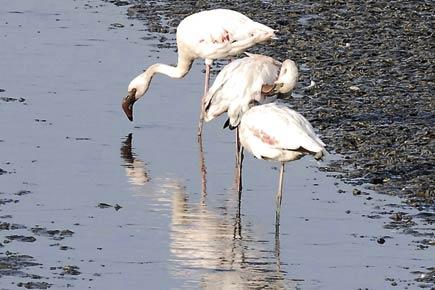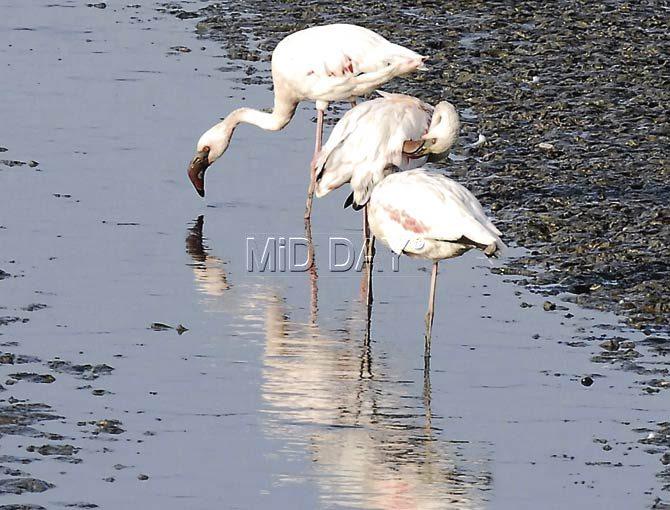With the Maharashtra government declaring the northern part of Thane Creek as a Flamingo Sanctuary last week, here’s a 360-degree view of what this means for the thriving ecosystem in our backyard

Factfile
What: Thane Creek Flamingo Sanctuary (reserved under Section 18 of the Wildlife Protection Act, 1972)
Where: The western bank of Thane creek between Airoli and Vashi bridges

Flamingo Sanctuary. Pic/Shadab Khan
Total Area covered: 1,691 hectares (16.9 sq km)
Break up: 143.16h (Mulund) + 257.35h (Vikhroli) + 94.92h (Bhandup) + 264.87h (Kanjurmarg) + 135.74h (Mandala) = 896h (mangrove cover along the western side of the creek); Creek area (partly exposed during low tide) = 795h
Number of flamingos: Around 20,000
Species: Lesser Flamingo and Greater Flamingo. Lesser Flamingo is more common with resident/breeding populations in India.
Flight path: They arrive in Mumbai by October/November and leave by early June (monsoon). They are believed to come from Gujarat and a few from the Middle East. BNHS is planning to do a PTT (Platform Transmitter Terminal) study about their flight path.
First sightings: Flamingos were first spotted and recorded in Sewri in 1994, and around the same time in Thane Creek.
Also spot: 200 bird species. This includes Oriental Stork, Black-headed Ibis, White-bellied Sea Eagle, Eurasian Curlew, Black-tailed Godwit, Caspian Tern, European Roller, Clamorous Reed Warbler and egret species like Night Heron and Little Heron.
Rare species: The Osprey, listed in Schedule I of Wildlife Protection Act, and the Greater Spotted Eagle, listed by International Union for Conservation of Nature (IUCN) as Vulnerable.
Species: Lesser Flamingo and Greater Flamingo. More common is Lesser Flamingo with resident/breeding populations in India, and the major stronghold is in parts of Africa. Greater Flamingo is far more widespread species with populations even in the Middle-East.
Birds of Thane creek: Published by the Mangrove Cell under the Government of India-GIZ Project on Coastal and Marine Protected Areas (CMPA), this 60-page booklet penned by Sunjoy Monga is a first-of-its-kind documentation on the diversity of bird life in the creek.
Information courtesy: Bombay Natural History Society (BNHS), Sunjoy Monga (naturalist, writer, photographer) and N Vasudevan (Chief Conservator of Forests, Mangrove Cell, Mumbai)
Voices
 Ashima Narain
Ashima Narain
Documentary filmmaker, In The Pink (2007)
This is good news as it protects an area with important faunal species as well as mangrove forests. This protection enables more science around the ecosystem to take place, and good science it at the heart of good conservation practice. Protection and conservation also increase awareness among so many of Mumbai’s residents who still have not seen these mangroves or the flamingos! It isn’t just the flamingos but understanding the importance of this ecosystem that enables over 200 species of birds to feed there.
Sunjoy Monga
Naturalist, writer, photographer In the early 1990s, I had clearly mentioned in a series of columns that if Mumbai’s vast mangrove cover was to be saved, and especially due to the wealth of biodiversity that they harbour, then it was crucial to have some pockets declared as protected, as a national park or sanctuary. Regulations such as CRZ only serve a certain purpose. So, in a way, even though so delayed, it is great news. However, I wish that the Sewri Bay too would have been brought under the protected area fold.
In the early 1990s, I had clearly mentioned in a series of columns that if Mumbai’s vast mangrove cover was to be saved, and especially due to the wealth of biodiversity that they harbour, then it was crucial to have some pockets declared as protected, as a national park or sanctuary. Regulations such as CRZ only serve a certain purpose. So, in a way, even though so delayed, it is great news. However, I wish that the Sewri Bay too would have been brought under the protected area fold.
N Vasudevan
Chief Conservator of Forests, Mangrove Cell, Mumbai This is one of the least explored areas in the city and the sanctuary will play the role of spreading awareness about the importance of conservation of mangroves, the flora and fauna and help wildlife researchers as well. The sanctuary also encourages the common man to visit the site and appreciate its natural diversity, especially in the midst of concrete conglomerate. Soon, we will be bringing out an elaborate coffee table book and an updated field guide too.
This is one of the least explored areas in the city and the sanctuary will play the role of spreading awareness about the importance of conservation of mangroves, the flora and fauna and help wildlife researchers as well. The sanctuary also encourages the common man to visit the site and appreciate its natural diversity, especially in the midst of concrete conglomerate. Soon, we will be bringing out an elaborate coffee table book and an updated field guide too.
Bahar Dutt
Environmental journalist, author At a time when most states are losing their forests to development activities, this is an extremely positive step taken by the Maharashtra Government. It's a rare and bold step which must be applauded. I can think of only one other state i.e. Karnataka that added more protected areas to its list. The challenge for this initiative is going to be how to control discharge of effluents etc, as this is dependent on factors that usually lie outside the protected area. This is going to be the real challenge for the Forest Department. I think every Mumbaikar knows the value of ecosystem services this initiative will provide. As for the flamingos, if they could understand us, I am sure they would do a merry dance! no, but seriously, one other state that needs to learn from Maharashtra is Gujarat which, instead of protecting the flamingo habitat, is building a road in the Rann of Kutch which will have a devastating impact. So I hope Maharashtra has set the example for other states to follow.
At a time when most states are losing their forests to development activities, this is an extremely positive step taken by the Maharashtra Government. It's a rare and bold step which must be applauded. I can think of only one other state i.e. Karnataka that added more protected areas to its list. The challenge for this initiative is going to be how to control discharge of effluents etc, as this is dependent on factors that usually lie outside the protected area. This is going to be the real challenge for the Forest Department. I think every Mumbaikar knows the value of ecosystem services this initiative will provide. As for the flamingos, if they could understand us, I am sure they would do a merry dance! no, but seriously, one other state that needs to learn from Maharashtra is Gujarat which, instead of protecting the flamingo habitat, is building a road in the Rann of Kutch which will have a devastating impact. So I hope Maharashtra has set the example for other states to follow.
Dr Deepak Apte
Director, BNHS-India
It is a good initiative. BNHS welcomes this positive move by the Government. Thane creek is a roosting area for flamingos while Sewri is the feeding area. If the feeding grounds are left unprotected, roosting areas will ultimately be left vacant. In order to offer complete protection to flamingos, even Sewri should be declared as a protected area.
 Subscribe today by clicking the link and stay updated with the latest news!" Click here!
Subscribe today by clicking the link and stay updated with the latest news!" Click here!







